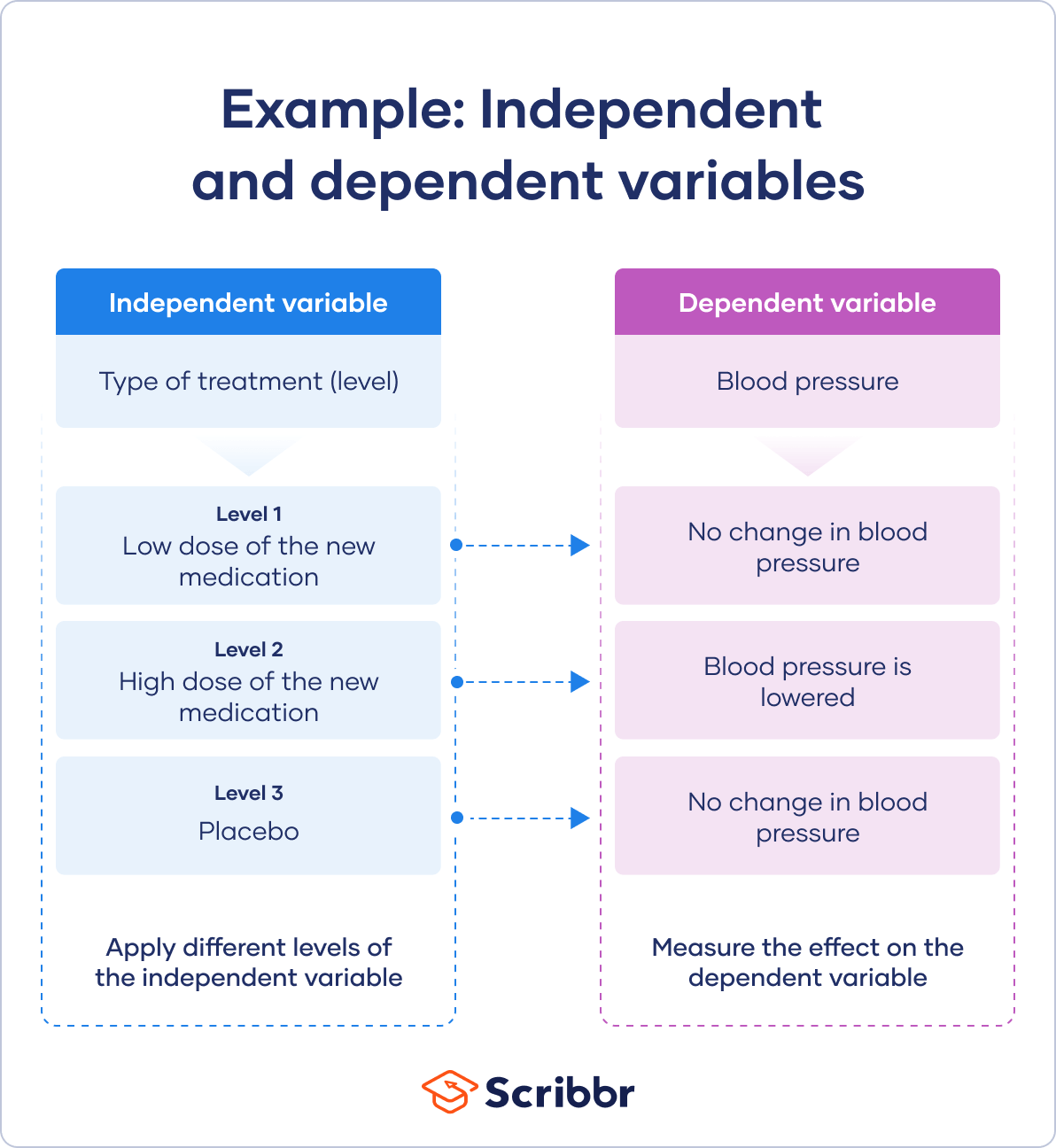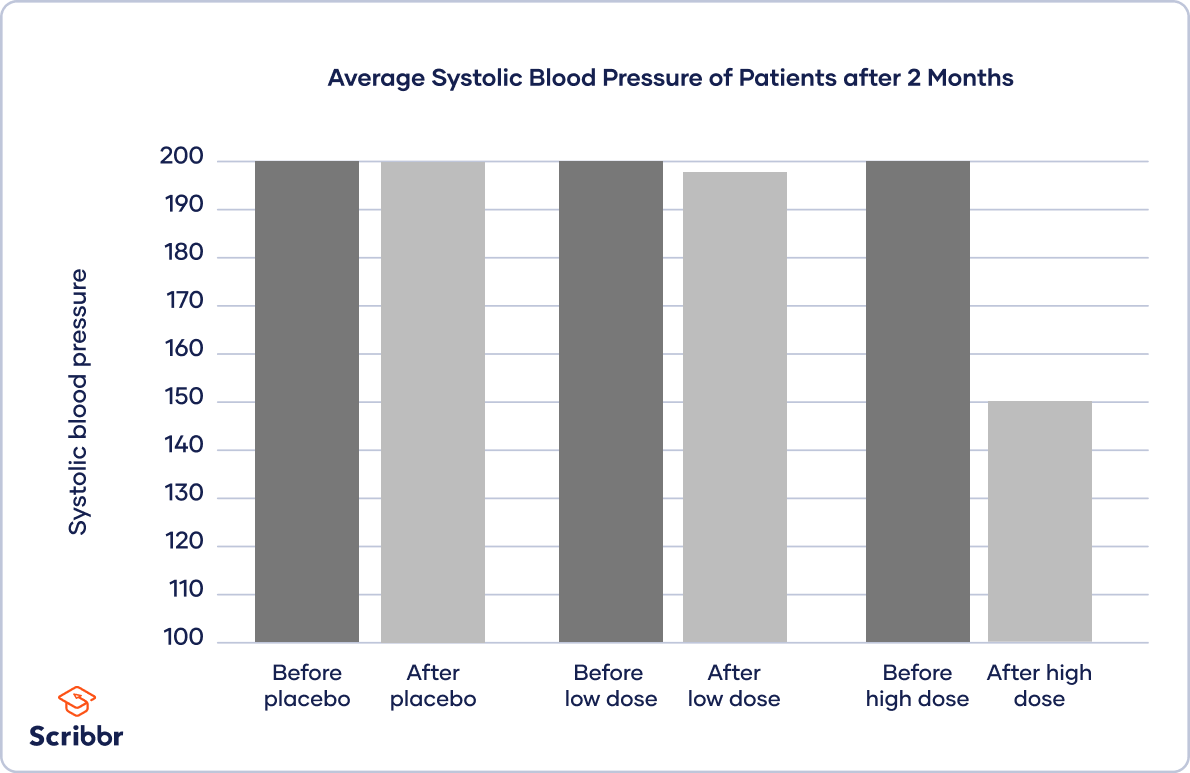Independent vs Dependent Variables | Definition & Examples
In research, variables are any characteristics that can take on different values, such as height, age, temperature, or test scores.
Researchers often manipulate or measure independent and dependent variables in studies to test cause-and-effect relationships.
- The independent variable is the cause. Its value is independent of other variables in your study.
- The dependent variable is the effect. Its value depends on changes in the independent variable.
Your independent variable is the temperature of the room. You vary the room temperature by making it cooler for half the participants, and warmer for the other half.
Your dependent variable is maths test scores. You measure the maths skills of all participants using a standardised test and check whether they differ based on room temperature.
Table of contents
What is an independent variable?
An independent variable is the variable you manipulate or vary in an experimental study to explore its effects. It’s called ‘independent’ because it’s not influenced by any other variables in the study.
Independent variables are also called:
- Explanatory variables (they explain an event or outcome)
- Predictor variables (they can be used to predict the value of a dependent variable)
- Right-hand-side variables (they appear on the right-hand side of a regression equation).
These terms are especially used in statistics, where you estimate the extent to which an independent variable change can explain or predict changes in the dependent variable.
Types of independent variables
There are two main types of independent variables.
- Experimental independent variables can be directly manipulated by researchers.
- Subject variables cannot be manipulated by researchers, but they can be used to group research subjects categorically.
Experimental variables
In experiments, you manipulate independent variables directly to see how they affect your dependent variable. The independent variable is usually applied at different levels to see how the outcomes differ.
You can apply just two levels in order to find out if an independent variable has an effect at all.
You can also apply multiple levels to find out how the independent variable affects the dependent variable.
You have three independent variable levels, and each group gets a different level of treatment.
You randomly assign your patients to one of the three groups:
- A low-dose experimental group
- A high-dose experimental group
- A placebo group
A true experiment requires you to randomly assign different levels of an independent variable to your participants.
Random assignment helps you control participant characteristics, so that they don’t affect your experimental results. This helps you to have confidence that your dependent variable results come solely from the independent variable manipulation.
Subject variables
Subject variables are characteristics that vary across participants, and they can’t be manipulated by researchers. For example, gender identity, ethnicity, race, income, and education are all important subject variables that social researchers treat as independent variables.
It’s not possible to randomly assign these to participants, since these are characteristics of already existing groups. Instead, you can create a research design where you compare the outcomes of groups of participants with characteristics. This is a quasi-experimental design because there’s no random assignment.
Your independent variable is a subject variable, namely the gender identity of the participants. You have three groups: men, women, and other.
Your dependent variable is the brain activity response to hearing infant cries. You record brain activity with fMRI scans when participants hear infant cries without their awareness.
After collecting data, you check for statistically significant differences between the groups. You find some and conclude that gender identity influences brain responses to infant cries.
What is a dependent variable?
A dependent variable is the variable that changes as a result of the independent variable manipulation. It’s the outcome you’re interested in measuring, and it ‘depends’ on your independent variable.
In statistics, dependent variables are also called:
- Response variables (they respond to a change in another variable)
- Outcome variables (they represent the outcome you want to measure)
- Left-hand-side variables (they appear on the left-hand side of a regression equation)
The dependent variable is what you record after you’ve manipulated the independent variable. You use this measurement data to check whether and to what extent your independent variable influences the dependent variable by conducting statistical analyses.
Based on your findings, you can estimate the degree to which your independent variable variation drives changes in your dependent variable. You can also predict how much your dependent variable will change as a result of variation in the independent variable.
Identifying independent vs dependent variables
Distinguishing between independent and dependent variables can be tricky when designing a complex study or reading an academic paper.
A dependent variable from one study can be the independent variable in another study, so it’s important to pay attention to research design.
Here are some tips for identifying each variable type.
Recognising independent variables
Use this list of questions to check whether you’re dealing with an independent variable:
- Is the variable manipulated, controlled, or used as a subject grouping method by the researcher?
- Does this variable come before the other variable in time?
- Is the researcher trying to understand whether or how this variable affects another variable?
Recognising dependent variables
Check whether you’re dealing with a dependent variable:
- Is this variable measured as an outcome of the study?
- Is this variable dependent on another variable in the study?
- Does this variable get measured only after other variables are altered?
Independent and dependent variables in research
Independent and dependent variables are generally used in experimental and quasi-experimental research.
Here are some examples of research questions and corresponding independent and dependent variables.
| Research question | Independent variable | Dependent variable(s) |
|---|---|---|
| Do tomatoes grow fastest under fluorescent, incandescent, or natural light? |
|
|
| What is the effect of intermittent fasting on blood sugar levels? |
|
|
| Is medical marijuana effective for pain reduction in people with chronic pain? |
|
|
| To what extent does remote working increase job satisfaction? |
|
|
For experimental data, you analyse your results by generating descriptive statistics and visualising your findings. Then, you select an appropriate statistical test to test your hypothesis.
The type of test is determined by:
- Your variable types
- Level of measurement
- Number of independent variable levels
You’ll often use t tests or ANOVAs to analyse your data and answer your research questions.
Visualising independent and dependent variables
In quantitative research, it’s good practice to use charts or graphs to visualise the results of studies. Generally, the independent variable goes on the x-axis (horizontal) and the dependent variable on the y-axis (vertical).
The type of visualisation you use depends on the variable types in your research questions:
- A bar chart is ideal when you have a categorical independent variable.
- A scatterplot or line graph is best when your independent and dependent variables are both quantitative.
To inspect your data, you place your independent variable of treatment level on the x-axis and the dependent variable of blood pressure on the y-axis.
You plot bars for each treatment group before and after the treatment to show the difference in blood pressure.
Based on your results, you note that the placebo and low-dose groups show little difference in blood pressure, while the high-dose group sees substantial improvements.
Frequently asked questions about independent and dependent variables
- What’s the definition of an independent variable?
-
An independent variable is the variable you manipulate, control, or vary in an experimental study to explore its effects. It’s called ‘independent’ because it’s not influenced by any other variables in the study.
Independent variables are also called:
- Explanatory variables (they explain an event or outcome)
- Predictor variables (they can be used to predict the value of a dependent variable)
- Right-hand-side variables (they appear on the right-hand side of a regression equation)
- What’s the definition of a dependent variable?
-
A dependent variable is what changes as a result of the independent variable manipulation in experiments. It’s what you’re interested in measuring, and it ‘depends’ on your independent variable.
In statistics, dependent variables are also called:
- Response variables (they respond to a change in another variable)
- Outcome variables (they represent the outcome you want to measure)
- Left-hand-side variables (they appear on the left-hand side of a regression equation)
- Why are independent and dependent variables important?
-
Determining cause and effect is one of the most important parts of scientific research. It’s essential to know which is the cause – the independent variable – and which is the effect – the dependent variable.
- What is an example of an independent and dependent variable?
-
You want to find out how blood sugar levels are affected by drinking diet cola and regular cola, so you conduct an experiment.
- The type of cola – diet or regular – is the independent variable.
- The level of blood sugar that you measure is the dependent variable – it changes depending on the type of cola.
- Can I include more than one independent or dependent variable in a study?
-
Yes, but including more than one of either type requires multiple research questions.
For example, if you are interested in the effect of a diet on health, you can use multiple measures of health: blood sugar, blood pressure, weight, pulse, and many more. Each of these is its own dependent variable with its own research question.
You could also choose to look at the effect of exercise levels as well as diet, or even the additional effect of the two combined. Each of these is a separate independent variable.
To ensure the internal validity of an experiment, you should only change one independent variable at a time.
- Can a variable be both independent and dependent?
-
No. The value of a dependent variable depends on an independent variable, so a variable cannot be both independent and dependent at the same time. It must be either the cause or the effect, not both.
Cite this Scribbr article
If you want to cite this source, you can copy and paste the citation or click the ‘Cite this Scribbr article’ button to automatically add the citation to our free Reference Generator.
Bhandari, P. (2022, October 17). Independent vs Dependent Variables | Definition & Examples. Scribbr. Retrieved 9 December 2024, from https://www.scribbr.co.uk/research-methods/independent-vs-dependent-variables/


